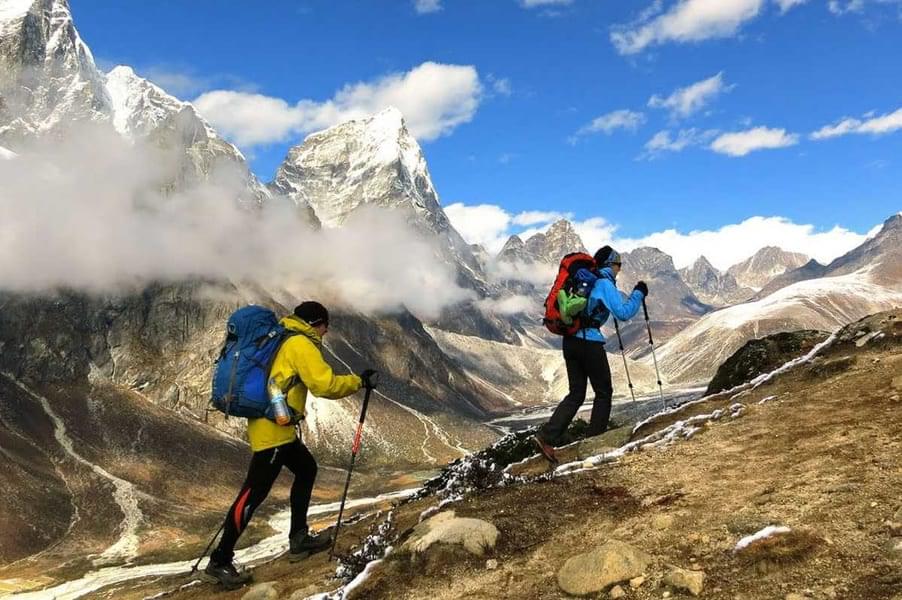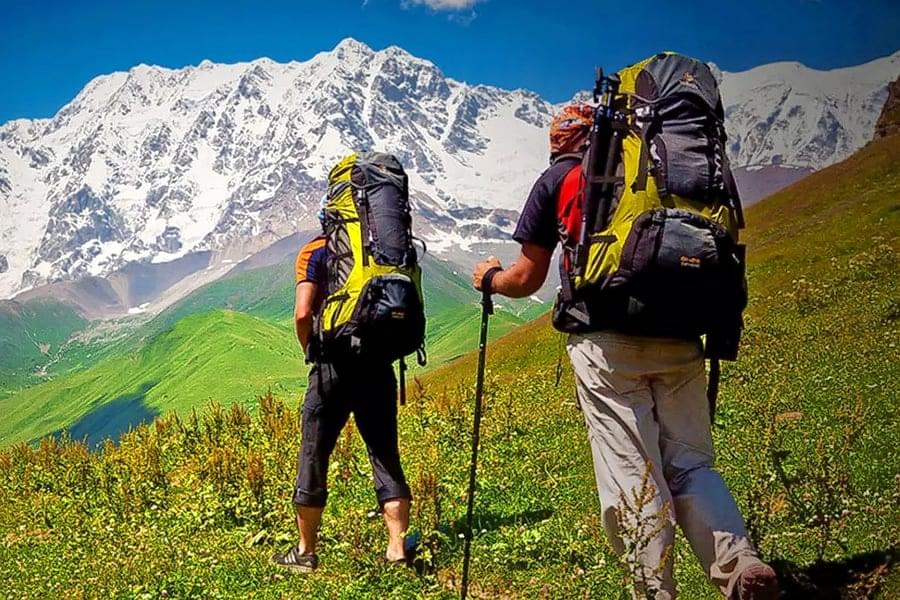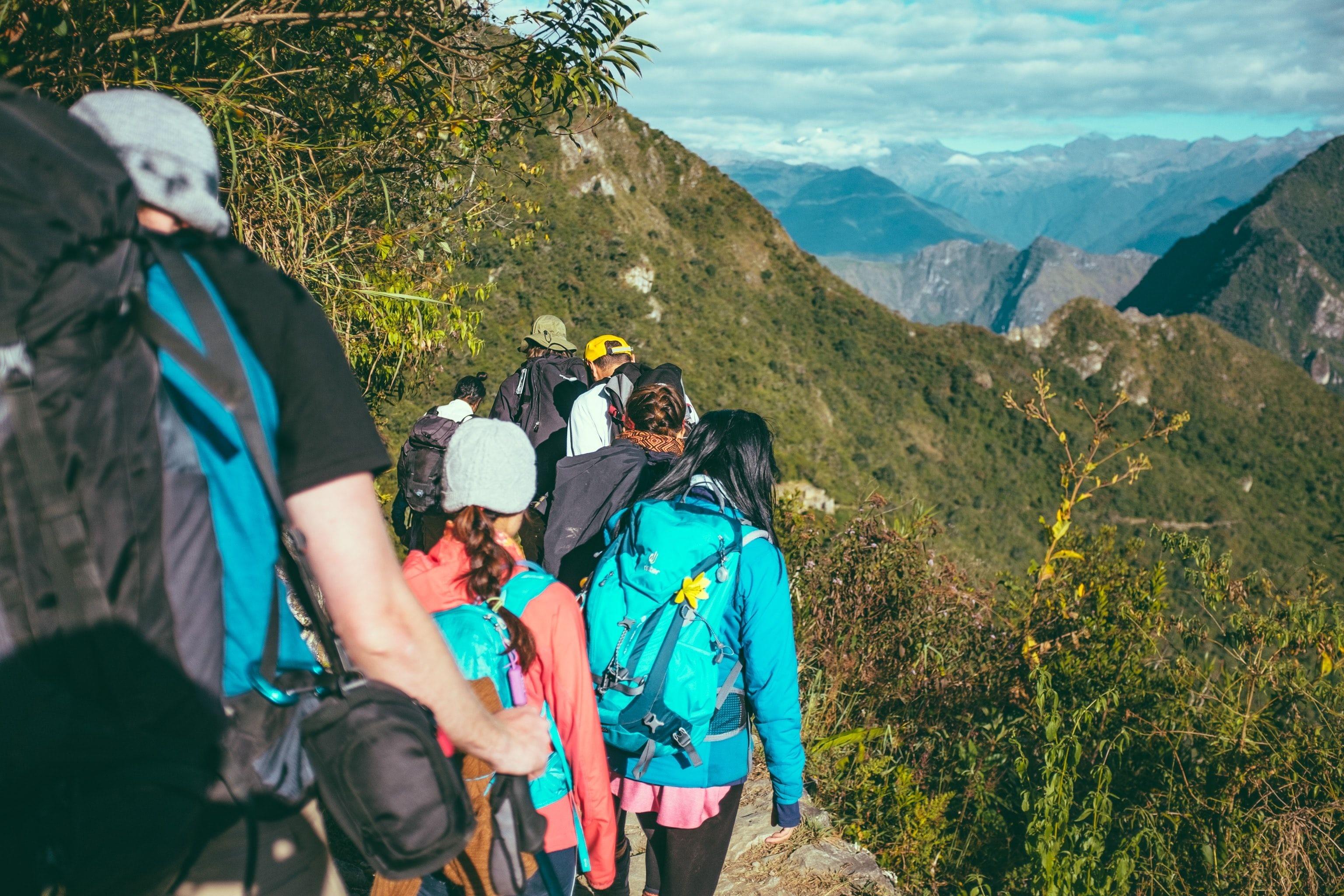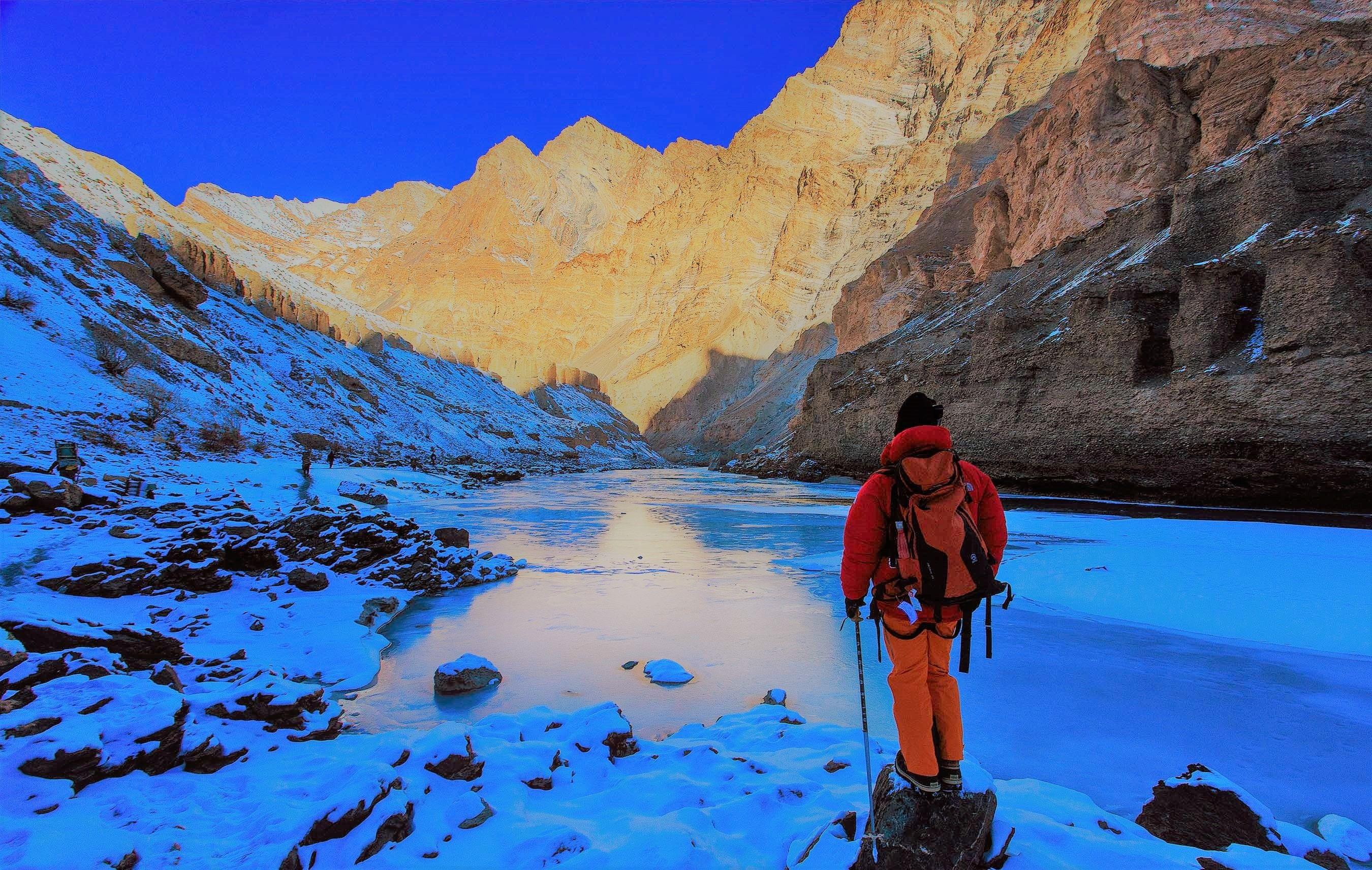Everest Base Camp Trek Overview
Brief Overview of the Trek
- Maximum Altitude of Everest Base Camp - 18,513 ft
- Duration - 8 Days
- Trekking Distance - 130 Kms
- Trail type - Difficult
- Airport - Tribhuvan Domestic Airport, Kathmandu
- Snow Season - Winter, usually starting in the month of November
- Service Available (in months) - throughout the year
- Base Camp - Lukla
- Best Season - April to early June and September to mid-December
- Region - Nepal
- Who Can Participate - The minimum age required to embark on the most thrilling trek is 15 years. The maximum age for this trek isn't specified, however if you're above 70, it would be advisable to proceed with extreme caution.Participants are required to have previous experience of at least one high altitude trek of upto 5,000/16,400 ft.
Short Glance At Itinerary For Mt. Everest Base Camp Trek
EBC Trek Detailed Itinerary
Trek Distance: 7 Kms | Duration: 3.5 Hours | Elevation: 2652m
A picturesque flight awaits us as we leave Ramechaap for Lukla, the entry point to the Everest region. With only one runway and a perilous location atop a cliff, this airport ranks among the most risky in the world.
When you get to Lukla, you will meet our representatives waiting to greet you.
Your first hike to Phakding begins after lunch as you follow the Dudh Koshi river's banks.
At Phakding, you spend the night.
Trek Distance: 10 Kms | Duration: 4 Hours | Elevation: 3440m
Prepare for the journey to Namche Bazaar after breakfast.
Huge, verdant mountain ranges frame the path, and the rivers Dudh Koshi and Bhote Koshi can be seen below on their respective suspension bridges.
You'll be stopping for lunch at Monjo, so stock up on nutritious necessities before continuing on to Namche, as this is the final place to eat before reaching that city.
Ascend a steep trail after receiving your Sagarmatha National Park permits at Jorsalle till you reach Namche Bazar.
On the side of a mountain shaped like an arch, you'll find Namche, the region's traditional commercial hub.
You'll be spending the night in Namche Bazaar.
Elevation: 3440m
The whole day you would stay in Namche for acclimatisation.
Spend the day sightseeing, shopping for essential items, exploring coffee shops and bars and finally dining a sumptuous meal at the restaurants.
At Namche Museum there is a lot to know about the history of the place which you can stop by while exploring the colourful Namche Bazaar.
Spend the night in the Mountain lodge/ stay houses of Namche.
Trek Distance: 8.6 Kms | Duration: 5 Hours | Elevation: 3860m
Have a hearty breakfast, and then pack up your things for the day's hike to Tengboche.
Take it slow on this flat and easy trail with stunning views of the Himalayas.
Explore the region and look for native animals like the Himalayan tahr and the monal.
Eat lunch in Phunki Tenga, a little town with teahouses and military outposts.
Discover the Khumbu region's largest Buddhist monastery, Tengboche, at the top of the mountain.
Reaching up to Deboche, make yourself comfortable and eat dinner in your house.
Spend the night in the peaceful town of Deboche, home to a number of monks.
Trek Distance: 11 Kms | Duration: 6 Hours | Elevation: 4360m
The next in the itinerary of Everest Base Camp trekking is passing the village of Pangboche through the Chortens and Mani walls.
In the village is located The Pangboche Monastery, where you’d find the fragmented mummified hand and the legends say that it came from a Yeti.
You would get tired after walking for 14 kms in upto 4 hours, then a lunch treat at Imja valley is a must before descending to Lobuche River.
Night stay would be arranged in Dingboche village for the day.
Elevation: 4360m
This another day would be spent in Dingboche for the purpose of acclimatisation and giving yourself some rest.
You would trek upto the sightseeing location of the world's top three mountain peaks- Mount Lhotse, Mount Makalu and Mount Cho Yu.
A perfect night stay would be arranged in the stay houses of Dingboche.
Trek Distance: 18 Kms | Duration: 4.5 Hours | Elevation: 4940m
You would leave Dingboche on day 7, to trek upto Dusa and along the edge to Dughla town.
While dragging yourself along the flat trail till Dughla you’d get to embrace the most beautiful Mount Everest base camp views of the expedition.
As you keep walking innumerable pinnacles like Taboche (6,542m/21463 ft), Cholatse (6,440m/21129 ft), Ama Dablam (6,856m/22493 ft), and Lhotse (8,516m/27940 ft) would cross your path.
After strolling 18 kms for over 4.5 hours across Dughla pass, you would reach Lobuche.
Finally, concluding your day at a height of 4940 metres, enjoy a tea and your stay at Tea House/ Mountain Lodge at Lobuche.
Trek Distance: 23 Kms | Duration: 6 Hours | Elevation: 5634m (Everest Base Camp)
It would really prove to be an adventurous day when you cover the longest trek so far through narrow mountain gaps with glacial moraines reflecting the morning sunlight alongside world’s highest Khumbhu glacier.
You would finally set your foot at the base camp after a 23 km long trek. After a brief lunch break before resuming the journey of Everest Base Camp trekking, as you reach the destination and enjoy every spilling emotion of happiness, victory captures every moment well.
After a 6 hour long trek and covering a trail upto the height of 5634 metre you would finally come back to Gorak Shep and stay there overnight.
Trek Distance: 11 Kms | Duration: 3 Hours | Elevation: 5550m (Kala Patthar)
After a tiring and long day, on the 9th day a short trek of 11 kms to Kala Patthar would be arranged.
You’d experience the beauty of an extraordinary sunrise view at an altitude of 5550 km which would compensate for all your hard work.
A trek back to Gorak Shep to enjoy a warm breakfast would conclude the day. After coming down to Pheriche, you’d have an overnight stay there.
Trek Distance: 19 Kms | Duration: 5.5 Hours | Elevation: 3440m
Descending the steep mountains would be fun, after a tasty breakfast at Pheriche you would come back to Namche after a 19 km long trek.
The 5.5 hour long trail would take you through Orso Somare and Pangboche tracing the west bank of Imja River.
While coming down to Namche Bazaar you would get through the dense forest of Tengboche and descend to Phunki Thengafor, where you would rest overnight.
Trek Distance: 18 Kms | Duration: 5 Hours | Elevation: 2800m
This would be the last day of trek, the challenging and soul stirring journey of Everest Base Camp trekking would be completed after descending a distance of 18 km.
You would cross over the Dudh Koshi river and take a descent route to Jorsaley national park while enjoying the blissful scenery en-route.
The trek would be headed towards Lukla via Phakding, where you would conclude the accomplishment of the most adventurous trek of Asia.
Spend a camp night at Lukla one last time and enjoy the peace and beauty of its night before returning back to your hay day life in cities.
- From Lukla, you would fly back to Kathmandu with the last glimpse of the heart melting views of Himalayas. Before finally moving back to your hometowns, take a last stroll around colourful backpackers hub Thamel.
Everest Base Camp Trek Packages
You are only a little distance away from reaching the world's summit. Cross "Trek to Everest Base Camp," a.k.a. "The World's Most Adventurous Hike," off your list.
Price Inclusions
Stay: Included in the price is your lodging in local Tea Houses or Mountain Lodges for the duration of your tour (11 nights).
Activities: Traveling to the foot of Mount Everest is a bucket list item for many.
Guide: During the trek, you'll be assisted and guided by a certified trek leader and a Sherpa. Each hiker may have their porter carry a maximum of 10 kg.
Permits: Permission to trek in Sagarmatha National Park, often known as a TIMS card. Permission to Enter the Khumbu Area. Inclusion of all federal, state, and local levies.
Transfers: Flights within the country, for transfers (Ramechhap- Lukla -Ramechhap)
You are only a little distance away from reaching the world's summit. Tick off the most daring Everest Base Camp Trek from your list.
Price inclusions
Stay: Tea Houses and Mountain Lodges for lodging throughout the tour (11 nights). Kathmandu hotels for overnight stays (02 nights)
- Activities: Journeying to the foot of the highest peak in the world
- Guide: All the way through the trek, you'll be assisted and guided by a certified trek leader and a Sherpa. Each hiker will have one porter carry up to ten kilogrammes of gear.
- Permits: Permits to trek in Sagarmatha National Park, also known as a TIMS card. Permission to Enter the Khumbu Area. All local and governmental fees.
- Transfers: Transportation to and from Kathmandu's airport. Pickup and Drop-Off at Ramechhap's Manthali Airport. Local flights (Ramechhap - Lukla - Ramechhap)
What to Pack for Your Everest Base Camp Trek?
- Heavy fleece or down jacket
- Moisture-wicking long-sleeve t-shirts
- Gortex or waterproof jacket with hood
- Fleece pants
- Moisture-wicking short-sleeve t-shirt
- Raincoats
- Windbreaker
- Hiking shorts
- Trekking pants
- Waterproof pants
- Hiking socks
- Long underwear
- Warm thermal socks
- Sock liners
- sweatshirt
Sunscreen
Toilet Paper
Lip balm with sunscreen
Advil or Ibuprofen
Antibiotics (Cipro for travellers’ diarrhoea)
Medical tape, Moleskin, duct tape for treating/preventing blisters
Diamox (for altitude sickness)
Anti-chafe balm
Diaper rash cream (Can treat rashes or chaffing)
Personal prescriptions
Soap
Toothbrush/toothpaste
Deodorant
Hand sanitizer
Shampoo
Razor (as needed)
Wet wipes
Face lotion
Feminine hygiene products
Duffle bag for carrying gear
Trekking Gear & Supplies
Water bottles or hydration bladder
Waterproof cover for daypack
40L Daypack
Lightweight water filter or iodine water tablets
Travel pillow or pillowcase
Headlamp with extra batteries
Sleeping bag rated to -18°C/ 0°F
Hand warmers
Camera with extra batteries and memory cards
Quick-drying trekking towel (optional)
Small lock(s) for duffle bag and daypack
Sleeping bag stuff sack
Drybags in several sizes
Stuff sacks for dirty clothes/shoes
- Snacks & Food
- Rehydration powder or gels
- Snacks (combine protein & carbs)
- Thermos (optional for hot beverages)
- Important Documents
- Visa
- Passport (needed at entry gate for registration)
- One passport-size photo
- Travel insurance
- Money ($200-300 cash is recommended)
- Additional Supplies
- Journal/pen
- Playing cards
- Portable solar charger/power bank
Know Before You Go to EBC Trek
Taking the 25-minute flight to Lukla from Kathmandu is the most convenient route to the Everest base camp. Due to ongoing repairs and renovations, however, flights between Kathmandu and Lukla are now departing via Ramechhap Airport (Manthali Airport) instead of the original route. Jiri is also accessible through road, which can be taken to continue on to Lukla. Additionally, a helicopter service is available to transport you from Lukla to Kala Pathar. To get to the base camp, also known as Gorak Shep, from Lukla, you'll have to pass through Phakding, Namche Bazaar, Thyangboche, Dingboche, and Lobuche.
Anytime from late May and mid-Sep is the ideal time to visit Everest Base Camp. The best times to embark on a hike are between the months of September and November, or February and May, when the weather is relatively predictable, the views are unobstructed, and the temperature at Base Camp rises to a comfortable minus six degrees Celsius. At the end of April or the beginning of May, you might also run into teams of mountaineers at Base Camp, getting ready for their summit bids on Everest. Although the temperatures between late November and early February are exceptionally low—around -15°C during the day and even lower at night—clear skies are typically the norm, and quieter routes and teahouses add to the exhilarating sense of untamed remoteness.
- January
It is possible to walk to Everest Base Camp in January even if there may not be much snow, but it is freezing.
- February and March
Nighttime temperatures in February and early March can drop to roughly -20°C, but clear skies should allow you excellent visibility of Everest during this time. In addition, there will be fewer people on the path, and the teahouses will be more peaceful, making the journey to Base Camp feel more like an expedition.
- March and April
March and April are peak hiking months because of the higher temperatures and the abundance of rhododendrons and other flowers further up the trail. The lengthening of the days means there will soon be plenty of time to go sightseeing, especially since the early mornings will be bright and clear. Late in April, you might see climbers in Base Camp acclimatising before starting their ascent to Camps I, II, and III on Everest's slopes, and then making an attempt at the summit.
- May
In early May, just before the monsoon, you can still make the trek to Base Camp, though you may have to share the area with mountaineers who are engaged in a series of 'rotations,' in which they climb higher and higher before retreating to Base Camp to rest and recoup before attempting to reach the summit.
- June July and August
The monsoon season in Nepal begins in late May and continues through the months of June, July, and August, into the beginning of September. Trails are muddy and infested with leeches, the mountains are frequently shrouded in cloud, and landslides are regular and disruptive to travel during the rainy season, even though it may not rain continuously throughout the day.
- September, October and November
Towards the end of September, as the monsoon winds down, the autumn trekking season begins. The weather is perfect for hiking in the months of October and November, thanks to the lack of precipitation and the resulting abundance of clear skies and clean air. Daytime highs are around -10 degrees Celsius at Base Camp, which is cooler than the spring season, but the days are dry and the scenery is beautiful.
- December
Even though it will be much cooler in late November and December (with nighttime lows well below freezing), these months are also ideal for going on a hiking adventure. People who want to avoid the cold will likely abandon their treks, which means the trail to Everest Base Camp will be much less crowded.
It is advisable to the trekkers to not bring any non-biodegradable material along and contribute to sustainable tourism.
While following the difficult Everest base camp trek, all the participants must follow the instructions of the trek leader and guide for their own safety.
Don't push yourself too hard; instead, take it easy and let your body relax and recuperate between daily hikes. Experiencing pain and exhaustion when hiking is inevitable, so make sure to get enough rest and take pain medication as needed.
All the participants are required to carry enough money at hand because you won’t find ATMs in Lukla at short distances.
Pack an efficient daypack with all the essentials like warm clothes, sunglasses, trekking boots, gloves, socks, woollen caps, medicines, rainwear, water bottles and other essentials
Before setting off on a trek, one of the most crucial things to consider is whether or not you have the proper gears. Thus double-check your gears to make sure nothing will let you down.
Take a note that sunburn at higher altitude might happen quicker, so keep your skin and eyes safe with moisturiser and sunglasses.
Keep extra batteries for head torch and other electronics handy as the batteries in cold might die quicker than at home.
- Don’t forget to carry water bottles along and keep yourself hydrated throughout the trek.
In order to reach Everest base camp, one can explore the various routes available. All the routes are unique, and adventurous in their own ways and ready to welcome you in their pleasant beauty while offering challenges simultaneously. However, here is explained the shortest route from Kathmandu to the base camp via Namche.
Kathmandu to Lukla ( 130-140 km) - The intriguing Everest base camp trek begins from Lukla which is the gateway to Everest region. In order to reach Lukla, you'd require to take a plane from Kathmandu and land at Lukla airport, one of the most risky airstrips in the world.
Lukla to Namche - After the commencement of the iconic trekking, As the trailhead and entry point for the EBC Trek, Lukla is where the journey begins. You begin your ascent from Lukla and hike to Phakding before continuing up to Namche Bazaar. Namche is a great tourist hub and is renowned for its breathtaking Everest view from a comfortable elevation.
Namche to Everest Base Camp- To reach the destination of base camp, on moving out of Namche trekkers would ascend to the villages of Pangboche, Tengboche, Dingboche, Lobuche and the renowned Gorakshep. The trail would continue for a minimum of 8-10 days.
General Trivia About EBC Trek
There are two base camps for Everest trekking, one in the North at Tibet and the other at South in Nepal. Everest Base Camp, in the Khumbu region of Nepal is the endpoint of this legendary trek for Everest.
While following the trek to the base camp you would pass the famous Sherpa village of Dingboche. It’s the home of Tenzing Norgay,the first person to climb Everest.
Edmund Hillary and Tenzing Norgay had marked the south base camp of Everest in Nepal and stored their supplies at the mountain base and that is how the Everest Base Camp was born.
Every trekker aspiring to climb Mount Everest makes sure to stop at Tengboche Monastery, which has the largest Buddhist gompa in the valley to light candles and seek blessings. Overtime, it has become a very significant ritual without which a trekking event won’t even be started.
Why To Go for Everest Base Camp Trek?
FAQ's of Mt. Everest Base Camp Trek
How difficult is the Everest Base Camp trek?
The trek to the Everest Base Camp is among the most difficult treks in Asia. But, that shouldn’t discourage you from going on the trek because the difficulty level of the trek is moderate. The trail of the trek passes through the villages of Nepal which are located at higher altitude. The passage is diverse, sometimes quite harsh but other times smooth, therefore the trekker won’t require any expertise and past experiences in trekking for joining in. You would be walking 8 hours per day for a continuous 12 to 14 days to finally land at the formidable Khumbu Icefall. Therefore, it’s advisable to add a good exercise schedule in your daily routine as well, to keep yourself in physically good shape to not face any problem during the trek like cramps and fatigue. he basics like walking, jogging, squats and stair climbing would be sufficient though you may add other exercises as per your bodily requirements. Try to be consistent with the exercise schedule and keep repeating the exercises for longer duration.
What is the best time to go on a trek at Everest Base Camp?
The schedules for Everest Base Camp are arranged throughout the year, but the best and suggested months to plan a trek would be March to Mid June ( spring season) and September to Mid December ( Autumn season). The valleys and villages of Nepal become more beautiful and pleasant during these months and seasons of the year.
How many days are required for Mount Everest Base Camp trekking?
The level of difficulty of the trek is modest and it takes around 12 to 14 days to complete it via the route from Lukla where you land after an adventurous plane ride from Kathmandu. The usual route passes through the town of Namche, villages of Pangboche and Dingboche and Khumbu region to finally land at the Everest Base Camp.
What are the package inclusions of Mount Everest trekking?
A round trip between Kathmandu and Lukla via flight.
Accommodations throughout the trip are covered in the package.
Different sightseeing short treks would be arranged.
Entry permits for Sagarmatha National Park, TIMS and Khumbu region would be covered.
The essential facility of porters who would carry luggage weighing upto 10 kgs.
A basic medical kit would be provided during the onset of the trekking.
What is the total length of the Everest Base Camp trekking?
The total length of the trek is around 130 Km, with 65 Km falling on each side. This distance can be usually covered between 12 to 14 days at ease.
Do you need any special training for the Everest Base Camp trek?
The trek of Everest Base Camp is considered moderately difficult, but you won’t require a special training to participate in the trek. The trek doesn't involve a very steep mountainous trail, it also has smooth and shaded pathways which makes the passage pleasant to tread. You may still include a basic set of exercises in your daily schedule like walking, cycling, swimming and other such cardiovascular activities.
How much heavy backpack should you pack for Mt. Everest Base Camp trek?
Your backpack should have the capacity to carry at least 60 Litres of weight. Don’t worry if you have packed extra stuff, you would have potters accompanying you to carry at least 10 kg of your load.
What are the nearby places in Kathmandu which can be visited?
While going for a trek to Everest Base Camp and your stay at Kathmandu you can visit other nearby places like Pashupatinath Temple, a sacred hindu temple complex; Thamel, a local market place which is quite famous for its coffee; Garden of Dreams, it’s the perfect place to rejuvenate your spirits after the 12 days long trekking tour; and, at last you can visit Hanuman Dhoka Temple.
What is the Everest base camp height?
The height of the Everest base camp varies. Like, the camp will be located at 5,380 m (18,513 ft) on the south side of Mount Everest in Nepal if your climb is beginning from the south east ridge. When approaching the Kala Pathar from the Gorakshep valley, your base camp elevation will be 5,545 metres.
Which is better: Everest Base Camp or Annapurna Circuit?
Because it is a longer route overall, the Everest Base Camp trek is more difficult than the Annapurna Circuit trek.The Annapurna circuit is a little easier because the average height is substantially lower, and there are less hard ascents.
Is Everest base camp hard?
Yes, it is a moderately demanding destination. Usually, two weeks are needed for the trek. The EBC Trek doesn't necessitate any prior trekking experience, but it is recommended that the trekker be both determined and physically fit.
Can a beginner go to Everest Base Camp?
Yes, Absolutely, beginners can participate in the Everest Base Camp Trek. The trek to Everest Base Camp is recognised for its gentle gradients and only a few hard ascents, making it certainly doable by beginners as well.
How cold does it get at Everest Base Camp?
It is quite cold at the Everest Base Camp. There is perpetual snow on top of Mount Everest besides a lot of severe weather. At Everest Base Camp, you can easily anticipate a nighttime temperature range of -20 to -3 degrees Celsius.
How far is the walk from base camp to Everest Summit?
From Nepal's Everest Base Camp, the peak of Everest is another 20 kilometres away. About 40 or 45 days are needed to make the ascent to the top of Everest. This is because hikers have to set up at least four separate camps in different areas, supply each one with essentials like food and fuel, and then return to the original base camp.
.png?w=auto&h=400)







